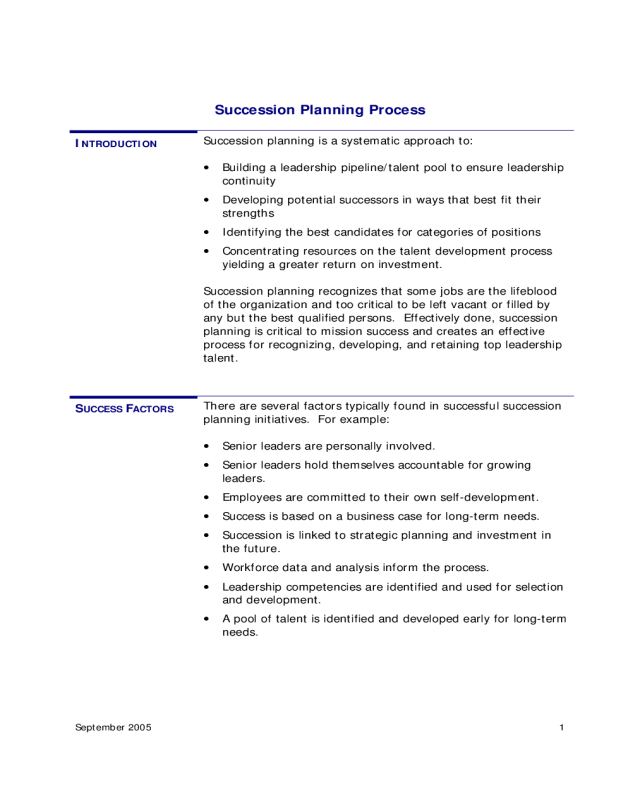Fillable Printable Succession Planning Process Template
Fillable Printable Succession Planning Process Template

Succession Planning Process Template

Succession Planning Process
I
NTRODUCTION
Succession planning is a systematic approach to:
•
•
•
•
Building a leadership pipeline/talent pool to ensure leadership
continuity
Developing potential successors in ways that best fit their
strengths
Identifying the best candidates for categories of positions
Concentrating resources on the talent development process
yielding a greater return on investment.
Succession planning recognizes that some jobs are the lifeblood
of the organization and too critical to be left vacant or filled by
any but the best qualified persons. Effectively done, succession
planning is critical to mission success and creates an effective
process for recognizing, developing, and retaining top leadership
talent.
S
UCCESS FACTORS
There are several factors typically found in successful succession
planning initiatives. For example:
•
•
•
•
•
•
•
•
Senior leaders are personally involved.
Senior leaders hold themselves accountable for growing
leaders.
Employees are committed to their own self-development.
Success is based on a business case for long-term needs.
Succession is linked to strategic planning and investment in
the future.
Workforce da ta and analysis inform the process.
Leadership competencies are identified and used for selection
and development.
A pool of talent is identified and developed early for long-term
needs.
September 2005 1

Succession Planning Process (continued)
S
UCCESS FACTORS
(CONTINUED)
•
•
•
Development is based on challenging and varied job-based
experiences.
Senior leaders form a partnership with human resources.
Succession planning addresses challenges such as diversity,
recruitment, and retention.
EFFECTIVE
SUCCESSION
PLANNING
The following information includes:
• A graphic representation of a six-step process for effective
succession planning
• A table with descriptions of each step in this process.
September 2005 2
Succession Planning Process (continued)
Step 1: Link
Strategic and
Workforce Planning
Decisions
This step involves:
•
•
•
•
•
•
•
•
•
•
•
•
•
•
•
Identifying the long-term vision and direction
Analyzing future requirements for products and services
Using data already collected
Connecting succession planning to the values of the
organization
Connecting succession planning to the needs and interests of
senior leaders.
Step 2: Analyze
Gaps
This step involves:
Identifying core competencies and technical competency
requirements
Determining current supply and anticipated demand
Determining talents needed for the long term
Identifying “real” continuity issues
Developing a business plan based on long-term talent needs,
not on position replacement.
Step 3: Identify
Talent Pools
This step involves:
Using pools of candidates vs. development of positions
Identifying talent with critical competencies from multiple
levels—early in careers and often
Assessing competency and skill levels of current workforce,
using assessment instrument(s)
Using 360° feedback for development purposes
Analyzing external sources of talent.
September 2005 3
Succession Planning Process (continued)
Step 4: Develop
Succession
Strategies
This step involves:
• Identifying recruitment strategies:
- Recruitment and relocation bonuses
- Special programs
• Identifying retention strategies:
- Retention bonuses
- Quality of work life programs
• Identifying development/learning strategies:
- Planned job assignments
- Formal development
- Coaching and mentoring
- Assessment and feedback
- Action learning projects
- Communities of practice
- Shadowing.
Step 5: Implement
Succession
Strategies
This step involves:
•
•
•
•
•
Implementing recruitment strategies (e.g., recruitment and
relocation bonuses)
Implementing retention strategies (e.g., retention bonuses,
quality of work life programs)
Implementing development/learning strategies (e.g., planned
job assignments, formal development, Communities of
Practice)
Communication planning
Determining and applying measures of success
September 2005 4
Succession Planning Process (continued)
Step 5: Implement
Succession
Strategies
(continued)
•
•
•
•
•
•
Linking succession planning to HR processes
– Performance management
– Compensation
– Recognition
– Recruitment and retention
– Workforce planning
Implementing strategies for maintaining senior level
commitment.
Step 6: Monitor and
Evaluate
This step involves:
Tracking selections from talent pools
Listening to leader feedback on success of internal talent and
internal hires
Analyzing satisfaction surveys from customers, employees,
and stakeholders
Assessing response to changing requirements and needs.
September 2005 5



